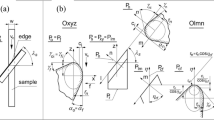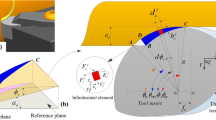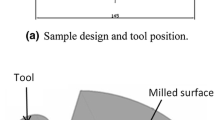Abstract
For finishing operations in machining, hardened steel hard turning can compete with grinding operations by means of accuracy and productivity. In the past research focussed on the effect of process parameters and tool macro geometry on the resulting surface roughness. Recent investigations show, that the cutting edge micro geometry is an important factor to influence surface quality. The knowledge generated by new methods displays the importance of asymmetric cutting edge roundings on cutting forces, chip formation and tool life. It is known, that chip formation also affects the resulting surface quality. Therefore, this paper investigates the effect of asymmetric cutting edge roundings on the resulting surface roughness in hard turning of roller bearing inner rings. Cutting tests with differently shaped cutting edges and two different feed values are conducted. The resulting surface roughness is measured. The consequent surface quality is explained by geometric coherences between uncut chip thickness and stresses along the cutting edge and the effect of material side flow. It is found, that the cutting edge geometry and the resulting stress distribution around the cutting edge affects the generated surface quality.








Similar content being viewed by others
References
Tönshoff HK, Arendt C, Ben Amor R (2000) Cutting of hardened steel. Ann CIRP 49(2):547–566
Brammertz P-H (1961) Die Entstehung der Oberflächenrauheit beim Feindrehen. Industrie-Anzeiger 2:25–32
Thiele JD, Melkote SN (1999) Effect of cutting edge geometry and workpiece hardness on surface generation in finish hard turning of AISI 52100 steel. J Mater Process Technol 94:216–226
Sokolowski AP (1955) Präzision in der Metallbearbeitung. VEB Verlag Technik, Berlin
Albrecht P (1960) New developments in the theory of metal-cutting process—part I. ASME Trans J Eng Ind 84(4):348–358
Brandt X (1995) Titel, Dr.-Ing. Dissertation, Universität Hannover
Denkena B, Grove T, Maiss O (2015) Influence of the cutting edge radius on surface integrity in hard turning of roller bearing inner rings. Prod Eng 9(3):299–305
Guddat J, M’Saoubi R, Alm P, Meyer D (2011) Hard turning of AISI 52100 using PSBN wiper geometry inserts and the resulting surface integrity. Proc Eng 19:118–124
Grzesik W (2008) Influence of tool wear in surface roughness in hard turning using differently shaped ceramic tools. Wear 265:327–335
Pekeharing AJ, Gieszen CA (1971) Material side flow in finish turning. Ann CIRP 20:21–22
Kishawy HA, Elbestawi MA (1999) Effects of process parameters on material side flow during hard turning. Int J Mach Tools Manuf 39:1017–1030
Liu K, Melkote SN (2006) Effect of plastic side flow on surface roughness in micro-turning process. Int J Mach Tools Manuf 46:1778–1785
Denkena B, Koehler J, Rehe M (2012) Influence of the honed cutting edge on tool wear and surface integrity in slot milling of 42CrMo4 steel. Proc CIRP 1:190–195
Denkena B, Lucas A, Bassett E (2011) Effects of the cutting edge microgeometry on tool wear and its thermo-mechanical load. CIRP Ann Manuf Technol 60(1):73–76
Bassett E, Koehler J, Denkena B (2012) On the honed cutting edge and its side effects during orthogonal turning operations of AISI1045 with coated WC-Co inserts. CIRP J Manuf Sci Technol 5(2):108–126
Fulemová J, Rehor J (2015) Influence of form factor of the cutting edge on tool life during finishing milling. Proc Eng 100:682–688
Denkena B, Biermann D (2014) Cutting edge geometries. CIRP Ann Manuf Technol 63(2):631–653
Altintas Y, Eynian M, Onozuka H (2008) Identification of dynamic cutting force coefficients and chatter stability with process damping. CIRP Ann Manuf Technol 57(1):371–374
Rehe M (2015) Herleitung prozessbezogener Kenngrößen der Schneidkantenverrundung im Fräsprozess, Dr.-Ing. Dissertation, Leibniz Universität Hannover
Acknowledgements
The authors thank the DFG (German Research Foundation) for supporting this project in the context of the research program “Resource Efficient Machine Elements (SPP1551)”.
Author information
Authors and Affiliations
Corresponding author
Rights and permissions
About this article
Cite this article
Maiss, O., Grove, T. & Denkena, B. Influence of asymmetric cutting edge roundings on surface topography. Prod. Eng. Res. Devel. 11, 383–388 (2017). https://doi.org/10.1007/s11740-017-0742-7
Received:
Accepted:
Published:
Issue Date:
DOI: https://doi.org/10.1007/s11740-017-0742-7




